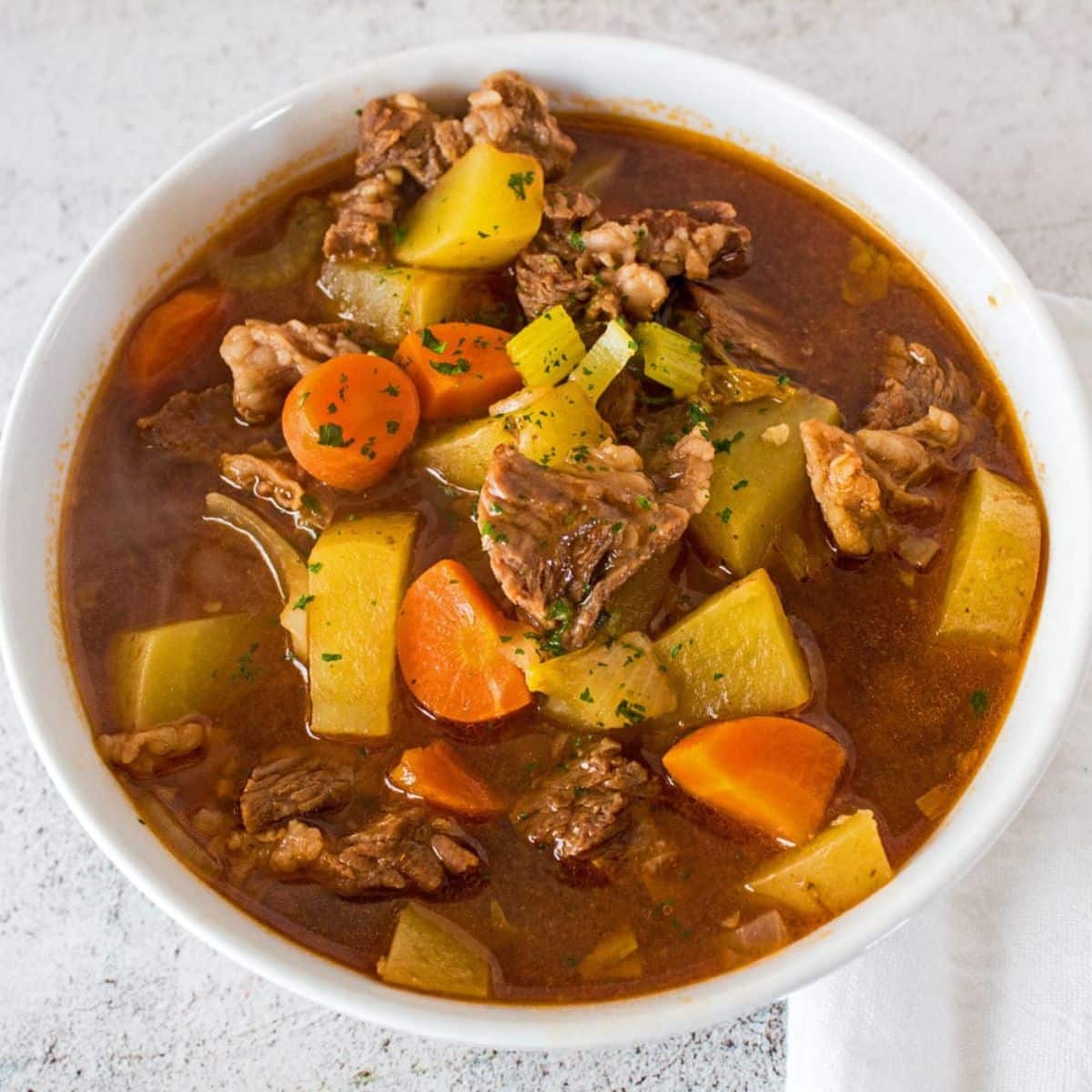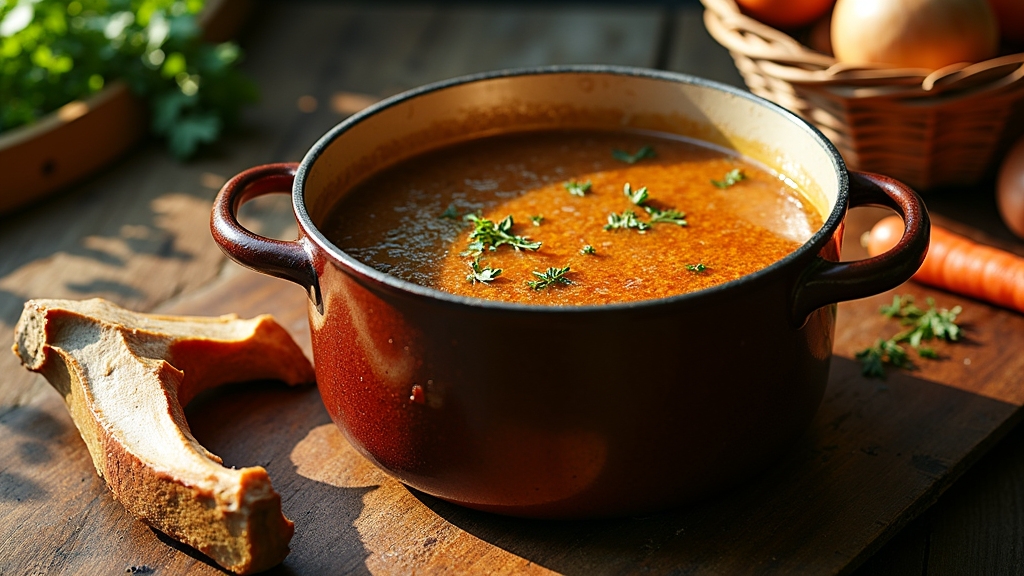Beef soup bones are a culinary gem, perfect for creating a rich, nourishing broth. I love roasting the bones first to deepen the flavor before simmering them for hours with aromatic vegetables like onions and garlic. The result is a hearty, savory soup that warms me up on chilly days. Plus, the nutritional benefits—like collagen and protein—make it even more appealing. If you’re curious about the best ways to enhance this dish, keep going to discover more tips!
History
When I think about the history of beef soup bones, I can’t help but feel a connection to centuries of culinary tradition. These bones have been a staple in kitchens around the world, each culture infusing them with unique flavors and techniques. From the hearty stews of Eastern Europe to the rich broths of Asia, they’ve always held cultural significance. I find it fascinating how people have relied on them for nourishment, creativity, and community. The slow simmering of bones extracts not just flavor, but also stories—stories of family gatherings and time-honored recipes. As we explore innovative ways to elevate this humble ingredient, we honor those traditions while crafting something new and exciting for our kitchens today.
Recipe
Beef soup bones are an excellent foundation for a rich, hearty soup that can warm you up on a chilly day. Using beef bones creates a deliciously deep flavor that infuses the broth, making it not only satisfying but also nourishing. The process may take a bit of time, but the end result is a comforting soup that’s perfect for family dinners or meal prepping for the week ahead.
To enhance the flavor, consider roasting the bones before adding them to the pot. This step caramelizes the meat and bones, resulting in a more complex and rich broth. Pairing your beef bones with fresh vegetables and herbs will elevate the dish, ensuring each bowl is brimming with taste and goodness. Get ready to enjoy a homemade soup that’s both delicious and rewarding!
Ingredients:
- 2-3 pounds beef soup bones
- 1 large onion, quartered
- 2 carrots, chopped
- 2 stalks celery, chopped
- 4 cloves garlic, minced
- 1 bay leaf
- 1 teaspoon black peppercorns
- 6-8 cups water
- Salt to taste
- Fresh herbs (like thyme or parsley) for garnish
Cooking Instructions:
In a large pot, add the beef soup bones along with the onion, carrots, celery, garlic, bay leaf, and peppercorns. Pour in enough water to cover the bones and vegetables, typically around 6-8 cups. Bring the mixture to a boil over high heat, then reduce the heat to low and let it simmer for 4-6 hours. Skim off any foam or impurities that rise to the surface during cooking. Once the broth is rich and flavorful, strain the solids out, season with salt to taste, and serve hot, garnished with fresh herbs.
Extra Tips:
For an even richer flavor, you can roast the beef bones in the oven at 400°F for about 30-40 minutes before adding them to the pot. Additionally, feel free to customize the soup by adding your favorite vegetables, such as potatoes or parsnips, during the last hour of simmering. If you want to make the soup ahead of time, let it cool completely before storing it in the refrigerator. The fat will solidify on top, making it easy to remove before reheating. Enjoy your delicious beef soup!
Cooking Steps
Now that we have our beef bones ready, let’s get started on the cooking steps that will transform them into a delicious broth. I’ll guide you through simmering the bones to extract rich flavors, adding fresh vegetables for that extra depth, and finally seasoning it all to perfection. Trust me, by the end of this process, you’ll have a comforting soup that warms the soul.
Step 1. Prepare the Beef Bones
To kick off the process, I recommend selecting high-quality beef bones that will enrich your soup with flavor and nutrients. Look for marrow bones, oxtails, or knuckle bones; these choices are packed with collagen and depth. Once you’ve secured your bones, it’s time to elevate your preparation techniques. Rinse them under cold water to remove any impurities, and then pat them dry with a clean towel. For an extra flavor boost, consider roasting the bones in the oven at 400°F for about 30 minutes until they’re beautifully browned. This step intensifies the umami flavor and creates a rich base for your soup. With well-prepared bones, you’re setting the stage for a savory, comforting dish!
Step 2. Simmer Bones for Flavor
Once the bones are prepped, I like to bring them to life by simmering them slowly in a large pot. I start by adding just enough water to cover them, letting the magic of slow cooking unfold. As the pot heats, I watch the marrow melt beautifully, infusing the broth with a richness that’s simply unparalleled. The key here is patience; I let the bones simmer on low heat for several hours, allowing all those deep flavors to develop. The aroma wafts through my kitchen, promising something special. This process not only extracts the nutrients but also creates a savory base that will elevate any soup. Trust me, this broth richness is worth every minute of wait!
Step 3. Add Vegetables for Depth
After the bones have simmered to perfection, it’s time to elevate the broth with fresh vegetables. I love to focus on my vegetable selection, choosing vibrant carrots, celery, and onions for their aromatic qualities. Their natural sweetness infuses the broth, creating a delightful balance with the rich meatiness. Next, I toss in some garlic and fresh herbs like thyme and bay leaves for a flavor enhancement that feels almost magical. As the vegetables cook down, they release their essence, deepening the broth’s complexity. Don’t overlook adding leafy greens at the end; they add a lovely freshness. This step transforms a simple soup into a nourishing, hearty dish that warms both body and soul. Enjoy the process; it’s all part of the journey!
Step 4. Strain the Broth
Straining the broth is an essential step that can make or break your beef soup. This process not only guarantees broth clarity but also enhances the overall flavor profile of your dish. When I strain my broth, I can almost feel the transformation happening. Here’s what I focus on:
- Choose the right strainer: A fine mesh sieve works wonders for trapping impurities.
- Let it cool slightly: This makes it easier to handle and reduces the risk of burns.
- Press gently: I use a spoon to press the solids, extracting every bit of flavor.
- Discard the solids: Once strained, the leftover bits won’t add anything more to your soup.
Step 5. Season to Taste
Seasoning is where the magic truly happens in your beef soup. Once you’ve strained the broth, it’s time to awaken those flavor profiles. I love starting with a generous pinch of sea salt; it’s essential for bringing out the natural richness of the beef. Don’t stop there—experiment with freshly cracked black pepper for a hint of warmth and complexity. For a twist, consider adding a touch of smoked paprika or a dash of cayenne for heat. Fresh herbs like thyme and rosemary elevate the dish, while a splash of balsamic vinegar adds depth. Always taste as you go; these seasoning tips transform your soup into a masterpiece that’ll leave your guests raving!
Nutritional Guide
As I plunge into the rich world of beef soup bones, I can’t help but appreciate their nutritional benefits, which make them a powerhouse for hearty meals. These bones are packed with essential nutrients that transform a simple broth into a nourishing elixir.
Here’s a quick ingredient analysis that highlights their benefits:
| Nutrient | Benefits |
|---|---|
| Collagen | Supports joint health and skin elasticity |
| Protein | Aids muscle repair and growth |
| Calcium | Essential for bone strength |
| Magnesium | Promotes heart health and energy production |
| Phosphorus | crucial for cellular function and energy |
Incorporating beef soup bones into your diet not only enhances flavor but also provides a wealth of nutrients to support overall wellness.
Final Thoughts
While cooking with beef soup bones might seem like a simple task, the depth of flavor and nutrition they bring to your meals is truly remarkable. These bones not only enhance the taste of various soup varieties, but they also pack a punch with their bone benefits.
Here’s why you should embrace beef soup bones in your kitchen:
- They create rich, hearty broths full of savory goodness.
- Packed with collagen, they support joint health and skin elasticity.
- They’re versatile, working well in a range of soup varieties, from hearty stews to delicate broths.
- Cooking with them is a sustainable way to utilize the whole animal.
Frequently Asked Questions
Can I Use Other Types of Bones for Soup?
I’ve experimented with poultry bones and even fish bones for broth. Each type offers unique flavors and nutrients, bringing a fresh twist to your soups. Don’t hesitate to innovate and explore different options!
How Long Can I Store Leftover Soup?
Did you know properly stored soup can last up to three days in the fridge? For leftover storage, keep it airtight to avoid soup expiration, and always trust your senses before diving in for that delicious taste!
Is It Safe to Freeze Beef Bone Soup?
Absolutely, I freeze beef bone soup all the time! For freezing safety, make sure it cools completely before storing. Proper bone storage in airtight containers keeps it fresh, letting me enjoy delicious soup later without worry.
What Are Good Sides to Serve With Soup?
When I serve soup, I love pairing it with crusty bread options that soak up the flavors. A fresh salad adds a vibrant crunch, creating a delightful contrast that makes each meal feel special and satisfying.
Can I Add Vegetables Directly to the Soup?
Yes, I can add vegetables directly to the soup, enhancing flavor and nutrition. Just keep cooking times in mind; quick cooking veggies should go in later for that perfect tender bite. Experiment with combinations!
Conclusion
As I ladle the rich, fragrant broth into a bowl, it feels like I’ve captured a moment in time—each sip a story of warmth passed down through generations. Just like a well-told tale, the depth of flavor unfolds with every taste, inviting you to linger a little longer. So, whether it’s a cold winter evening or a gathering of friends, let this humble soup be the hearth around which memories are created, nourishing both body and soul.

Soup Bones Beef Recipe
Ingredients
Equipment
Method
- Preheat oven to 400°F (200°C).
- Place beef bones on a baking sheet, drizzle with oil, and roast for 30-40 minutes until browned.
- In a large stockpot or slow cooker, heat oil over medium heat.
- Add onions, carrots, and celery. Sauté for 5 minutes until softened.
- Stir in garlic and tomato paste (if using) for 1 minute.
- Add roasted bones, peppercorns, bay leaves, thyme, and vinegar.
- Pour in enough water to fully submerge the bones (about 3-4 quarts).
- Stovetop Method: Simmer on low heat for 6-8 hours, skimming foam occasionally.
- Slow Cooker Method: Cook on LOW for 12-24 hours for maximum richness.
- Remove bones with tongs. Strain broth through a fine-mesh sieve or cheesecloth.
- Discard solids (or pick remaining meat for soups).
- Season with salt to taste.
- Let broth cool before refrigerating (up to 5 days) or freezing (3+ months).
- Skim solidified fat if desired.
Notes
- For deeper flavor: Add mushrooms, parsley stems, or a splash of red wine.
- Gelatinous texture indicates a well-made broth (thickens when chilled).
- Instant Pot Option: Cook on HIGH pressure for 2-3 hours, then natural release.

